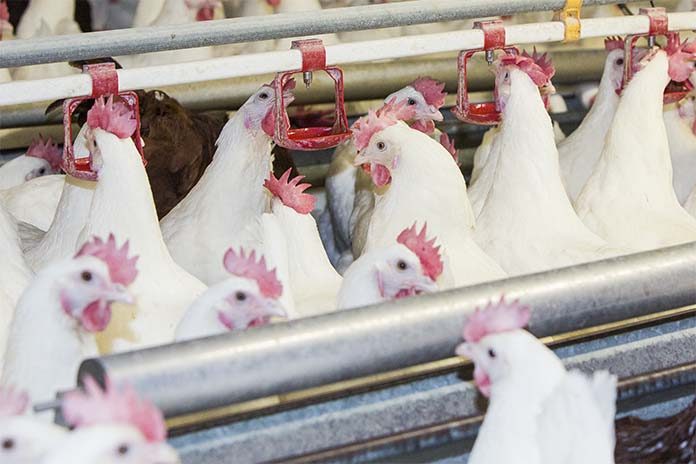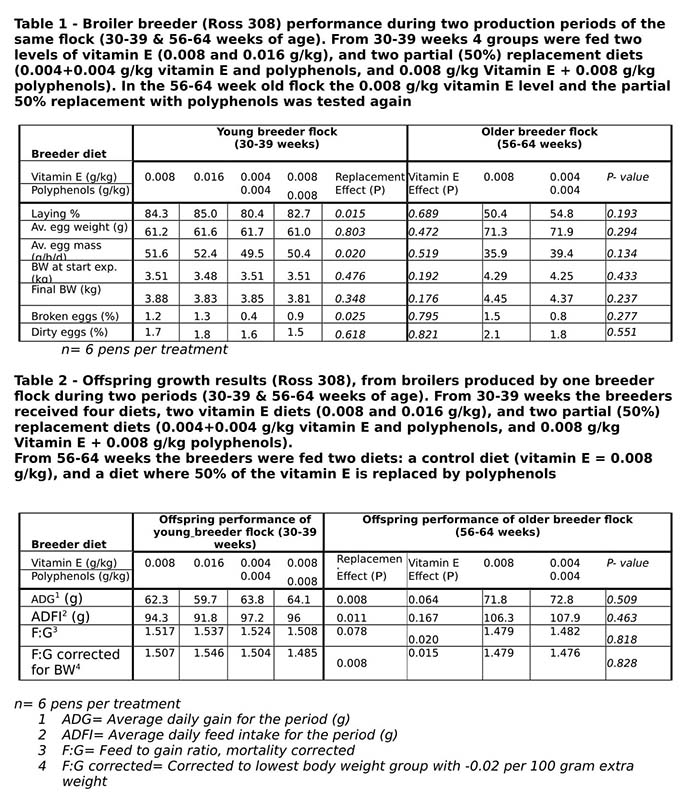
In a series of experiments, it was shown that antioxidants in broiler breeder diets can affect broiler performance trans-generationally. To study this, a polyphenol blend with high antioxidant properties was used to partially replace (50%) vitamin E in breeder diets.
Chick weight was found to be significantly heavier at hatch, and offspring growth performance (average daily gain) improved significantly in young breeder offspring, while this effect was not observed when only the vitamin E level increased in the breeder diet. The study shows that partial replacement of dietary vitamin E (50%) with a polyphenol blend in breeder diets can improve offspring performance.
Antioxidants are an important dietary component of animal diets. They counter oxidation and limit oxidative stress. There exists an antioxidant-oxidant balance in animal tissues. Vitamin E, vitamin C & vitamin A are vitamins that provide an anti-oxidative defense. Besides vitamins, also carotenoids and the enzymes glutathione peroxidase (GSH-PX), catalase (CAT) and superoxide dismutase (SOD) are important antioxidants in maintaining this balance.
Animal nutrition research has recently been focusing on the antioxidant capacity of polyphenol compounds. The avian embryo development relies on antioxidants accumulated in the egg yolk via breeder diet. Various antioxidants that belong both to enzymatic and non-enzymatic groups can counter oxidative stress, but it is not well described how antioxidants interact with each other. Overall anti oxidation capacity might help optimal embryonic development, and therefore possibly also post-hatch performance.
In order to evaluate if a variation in dietary antioxidant status in breeding bird diets affects offspring performance, it was tested whether a 50% replacement of dietary vitamin E by a selected combination of polyphenols influences breeder performance, embryo development -/- hatchability and post-hatch growth performance. The results are described in this paper.
Materials and methods
Two breeder experiments were performed at the Cargill Innovation Center in Velddriel, the Netherlands. A single flock of broiler breeders was used in two periods (1st period=30-39 weeks of age, and the 2nd period=56-64 weeks of age). The eggs produced by these broiler breeders, at the end of both trial periods, were collected and incubated. Fertility and hatchability were measured for both breeder groups during both trial periods. Last, the performance of the broilers that hatched from the two breeder groups was measured. The connected experiments are described in more detail below. Proviox™, a blend of natural antioxidants that in anti-oxidative activity equals vitamin E50 (vitamin E equivalent), was used to replace vitamin E in the diet.
Broiler breeders
Two experiments were performed with the same animals (1st experiment = young flock: 30-39 weeks old, and 2nd experiment = older flock: 56-64 weeks old). The flock consisted of 730 females and 92 males (Ross 308 broiler breeders). The animals were commercially obtained (Pluvita B.V., the Netherlands) and were randomly assigned to 24 floor pens. Each pen contained 3 males and 30 females.
The animals received the same diet during the six week pre-experimental periods. During the first 9-week experimental period (30-39 weeks old) four diets were fed: two levels of vitamin E (0.008 g/kg and 0.016 g/kg) and two diets where 50% of the vitamin E was replaced with polyphenols, (0.004 g/kg vitamin E + 0.004 g/kg polyphenols and 0.008 g/kg vitamin E + 0.008 g/kg polyphenols).
At 56-64 weeks old two diets were fed, a control diet, and a diet where 50% of the vitamin E was replaced by polyphenols. The control diet contained 0.008 g/kg vitamin E. The treatment diet contained 0.004 g/kg vitamin E and 0.004 g/kg polyphenols (a 50% replacement of vitamin E). In the second experiment two other treatments were evaluated, but due to the scope of this paper not described here. Female and male diets were isoenergetic, containing respectively 145 and 130 g/kg crude protein. The diets were corn, wheat, soybean meal based. No differences occurred in crude fat, crude fiber, dry matter, amino acid levels, minerals or vitamin levels between the two treatment groups. Diets were produced by Research Diet Services BV (RDS), Wijk bij Duurstede, the Netherlands.
Incubation, fertility & hatchability
Eggs from both breeder groups were collected after feeding the experimental diets for 6 weeks, and were incubated in the same incubators. Eggs were incubated at the In Ovo Bioassay research facilities of the Cargill Innovation Center in Velddriel, the Netherlands. For a 6-day period (young flock) and 11-day period (older flock), eggs were collected from the two groups of broiler breeders. Eggs were stored and incubated in blocks based on breeder pen and storage day. Only intact, clean eggs were included. The eggs were placed in a NatureForm NMC 2340 incubator with automatic temperature and relative humidity controls. The temperature was initially set at 37.5°C (E0), and was gradually decreased to 36.7°C (E12 until E18). At E7 and E18 all eggs were candled and empty eggs or eggs containing dead embryos were recorded and removed. Eggs were transferred to hatching baskets at E18, kept in the same groups as during setting. At hatch (E21) the number of dead chickens, late dead embryos (E19-E21) and pipped eggs were recorded. The number of hatched chickens was recorded per replicate, as well as average chicken weight. Hatchability was calculated as the percentage of total eggs set.
Offspring
Growth performance was measured twice (once with hatchlings from the eggs laid at 38-39 weeks of age, and once with the hatchlings from the eggs laid at 63-64 weeks). The first experiment lasted until 35 days and the second until 34 days. All the chickens were produced by the two dietary groups of broiler breeders. Chickens were sexed at hatch. 504 males were included in the growth performance trials. Only completely dry chickens, showing active movement and with a good navel score were included. Floor pens were used with 90 x 225 cm floor area per pen. One feed was fed to the offspring. Water and feed were provided ad libitum.
Statistical analysis
Performance parameters (normal distribution), hatchability and embryonic mortality (binomial distribution) were subjected to mixed model analysis using the PROC MIXED procedure in SAS (version 9.3, 2011, SAS Institute Inc., Cary, NC) using breeder pen as the experimental unit.
For experiment 1, contrasts were used to determine significant relationships for 1) the effect of partially replacement by polyphenols, and 2) the effect of vitamin E. For experiment 2, again contrast 1 was used to determine significant relationships. Data are expressed as least square means. Effects were considered to be significant when P < 0.05.

Results and discussion
Broiler breeder performance
Breeder performance results are presented in Table 1. In young breeders the partial replacement (50%) of vitamin E with polyphenols decreased breeder laying percentage. This effect was not found in older breeders. Polyphenols reduced the amount of broken egg shells in young breeders.
Incubation, fertility & hatchability
Egg weight, fertility, hatchability (%), yolk free body mass and chick length were not significantly different between the two groups in both periods (P>0.05). Higher average chick weight (P=0.018) and higher relative chick weight (P=0.012) were found in the polyphenol replacement group in hatchlings from the older brood stock.
Offspring performance
Offspring performance is shown in Table 2. Body weight at day 1 did not differ in the two trials between the two groups included in the grow-out trial (P=0.518 in the offspring of the young flock & P=0.790 in the offspring of the older flock respectively). Mortality did not differ in the two trials between the two groups.
In offspring of young broiler breeders, a trans-generation effect of vitamin E supplementation by polyphenols resulted in significant improvement in broiler performance, while a higher vitamin E level decreased offspring performance. When 43-week old Indian River broiler breeders were fed a diet supplemented with 0.3g/kg vitamin E, it did not have any effects on offspring weight gain.
A dose response study of vitamin E (0.025, 0.050, 0.075 and 0.1 g/kg) using 24-54 wk old Ross broiler breeders also showed no difference in laying percentage, egg production, hatchability, or offspring chick weight. Vitamin E was transferred from hen diet to egg up to 0.075 g/kg, but offspring weight gain, feed conversion ratio, or livability were not significantly affected by the dietary vitamin E level. A single elevation of vitamin E has then the desired effect of increasing antioxidant level of the offspring, but this does not result in higher offspring performance.
References are available on request
From the Proceedings of the Australian Poultry Science Symposium

















